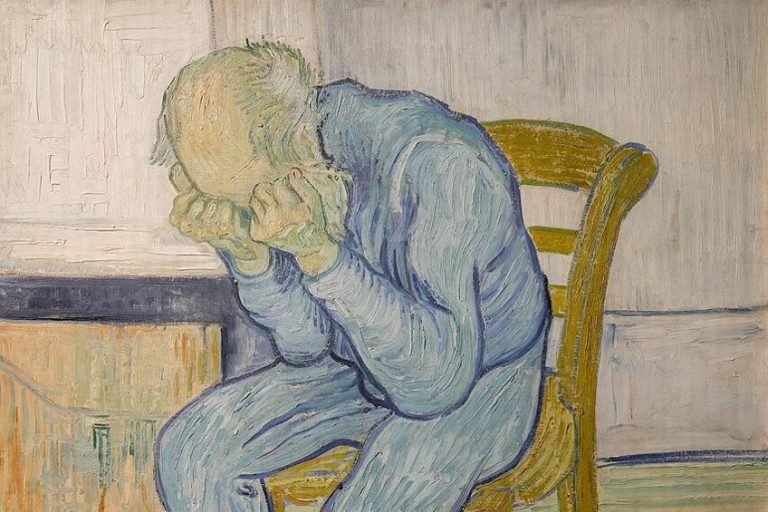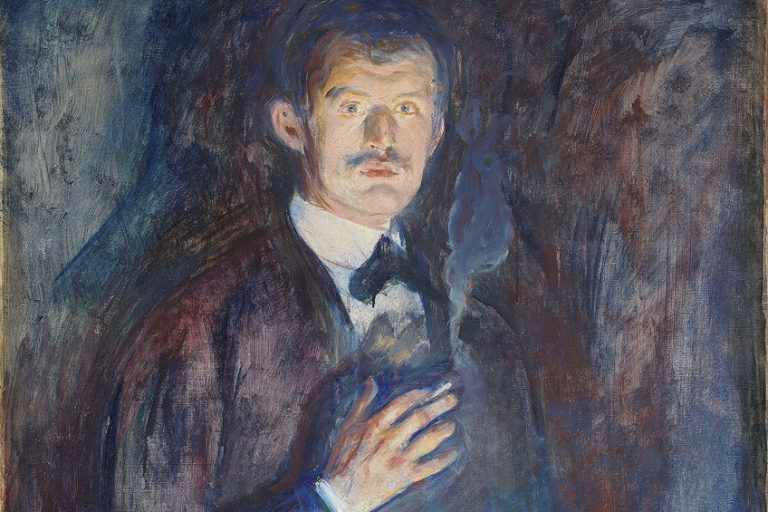Kurt Schwitters – Discover Kurt Schwitters Artwork
Kurt Schwitters was a renowned German artist whose innovative artwork and groundbreaking approach to collage have left an indelible mark on the art world. He is best known for his revolutionary collage technique, which involved combining various materials and objects to create visually striking and thought-provoking compositions. Throughout his career, he continually pushed the boundaries of traditional art forms, leaving a lasting heritage that persists to encourage and delight viewers and artists worldwide. In this article, we will look at what made this artist so influential, as well as answer questions like, “how did Kurt Schwitters die?”, “where did Kurt Schwitters live?”, and “when was Kurt Schwitters born?”.
Artist Abstract: Who Was Kurt Schwitters?
| Date of Birth | 20 June 1887 |
| Date of Death | 8 January 1948 |
| Place of Birth | Hanover, Germany |
| Nationality | German |
| Associated Art Movements | Dadaism, Modern art, Surrealism, and Merz |
Kurt Schwitters, a visionary German artist born on June 20, 1887, in Hanover, embarked on an extraordinary artistic journey that would shape the course of modern art. From his formative years to his significant contributions to the Dada movement, Schwitters left an indelible mark on the art world. This article delves into the various phases of Schwitters’ life, including his childhood, training, early artworks, major career achievements, and his profound influence on Dadaism and art history at large.

Childhood and Training
Kurt Schwitters grew up in a middle-class family in Hanover, Germany. Although his family urged him to seek a career in law, Schwitters’ passion for art prevailed. He received formal training at the Dresden Academy of Fine Arts and later at the Hanover School of Applied Arts.
These educational experiences laid the foundation for his artistic development, equipping him with technical skills and fostering his creative spirit.
Early Artworks
During his early years as an artist, Schwitters experimented with various styles, including Impressionism and Expressionism. His early works reflected the influence of the German Romantic tradition, yet Schwitters sought to break free from traditional boundaries. In 1919, he formed the artists’ group Die Merz, which became the platform for his exploration of unconventional techniques and materials.
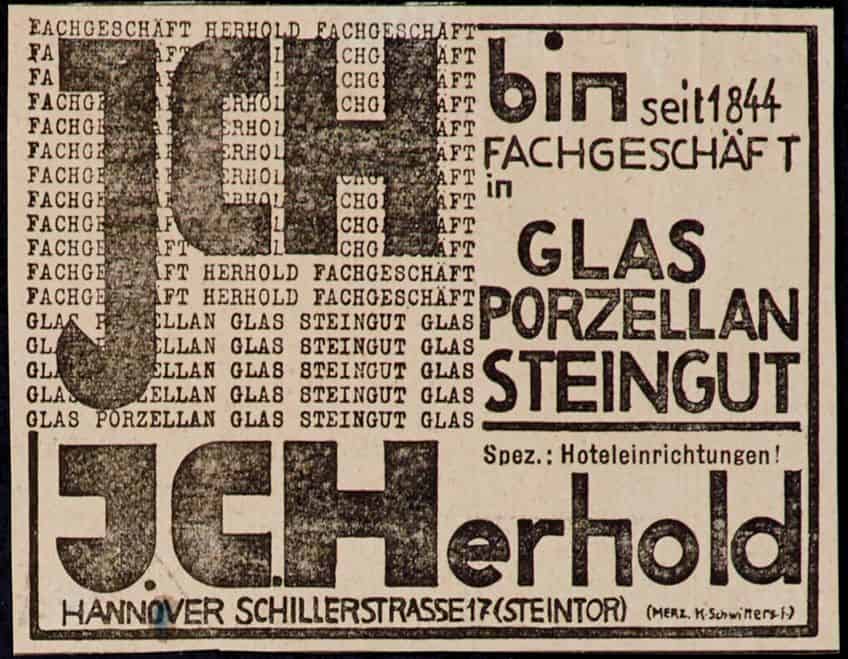
Die Merz: So Much More than Just an Art Style
Merz art style, pioneered by Kurt Schwitters, is a distinctive artistic approach that encompasses collage, assemblage, and the incorporation of found objects. The term “Merz” originated from a fragment of the word “Kommerz” (commerce) found on a piece of paper Schwitters was using in one of his collages. He adopted the term to represent his artistic philosophy, which aimed to merge disparate elements of everyday life into a cohesive artistic expression.
In Merz art, Schwitters would collect and repurpose discarded materials such as newspaper clippings, packaging, fabric scraps, and various objects.
He would then arrange and combine these fragments to create visually dynamic and thought-provoking compositions. Schwitters believed that by incorporating fragments of the real world, he could give new meaning and aesthetic significance to otherwise mundane objects. The Merz art style went beyond traditional artistic boundaries, rejecting the idea that art should be confined to specific mediums or materials. Schwitters sought to blur the distinction between art and life, emphasizing the integration of art into the everyday experience. The resulting works were often characterized by their visual complexity, juxtaposition of disparate elements, and a sense of poetic abstraction.

Schwitters’ Merz collages and assemblages were not confined to two-dimensional surfaces but also extended to three-dimensional installations, most notably his long-term project known as the Merzbau (1923-1937). The Merzbau was an evolving architectural environment that occupied several rooms and featured a labyrinthine network of collaged materials and found objects.
Overall, Merz art style embodies Schwitters’ innovative and experimental approach to art, challenging traditional notions of artistic practice and opening new possibilities for creative expression. Its influence continues to resonate in contemporary art, particularly within the realms of assemblage, found-object art, and mixed-media collage.
Major Career Achievements
Kurt Schwitters’ artworks are famously versatile and he explored many different styles in his life. This made him a multifaceted artist that achieved many great things in his life. Let us look at one of the milestones of his career.
The Merz Magazines
Schwitters also established the Merz magazines and publications that served as platforms for showcasing his artistic vision. The magazines featured avant-garde poetry, essays, and artwork, contributing to the dissemination of Dadaist ideas and the forging of international artistic connections.
From Merz to Dadaism: Kurt Schwitters’ Influence on a Revolutionary Art Movement
The post-war era of the early 20th century witnessed the emergence of artistic movements seeking to challenge established norms and make sense of a rapidly changing global socio-political context. One such movement, Dadaism, was heavily influenced by the innovative Merz art style pioneered by Kurt Schwitters. This article explores how Schwitters’ Merz approach to art not only influenced but also played a significant role in the rise of Dadaism.
It delves into the post-war context, where artists sought to grapple with the chaos and disillusionment of the time, using artistic expression as a means to make sense of the world.
The Post-War Context
Following the devastation of World War I, society was faced with a profound sense of disillusionment, shattered ideals, and a desire to redefine traditional values. The post-war context became fertile ground for artistic experimentation and the questioning of established artistic conventions. It was within this backdrop that artists, including Kurt Schwitters, sought to challenge the existing order and create new forms of expression.

Merz: Blurring Boundaries and Transforming Art
Schwitters’ Merz art style, which he began developing in the early 20th century, was instrumental in pushing artistic boundaries. Merz involved the fusion of disparate materials and objects, often discarded fragments of everyday life, to create visually dynamic and conceptually rich compositions.
By incorporating elements of the real world, Schwitters aimed to infuse art with new meaning and to challenge the traditional distinctions between art and life.
The Influence on Dadaism
The Merz art style served as a catalyst for the emergence of Dadaism, an avant-garde movement that sought to rebel against established artistic and societal norms. Dadaists embraced Schwitters’ approach of utilizing found objects, collage, and assemblage to create provocative artworks. The subversive and anti-establishment nature of Merz aligned perfectly with the Dadaist ethos, allowing artists to express their disillusionment, frustration, and desire for radical change.

Legacy and Impact
The influence of Schwitters’ Merz art style on Dadaism was significant and enduring. Dadaism went on to inspire subsequent art movements, including Surrealism and Pop Art, and influenced the trajectory of modern and contemporary art. The rebellious and transformative spirit of Dadaism, rooted in the Merz approach, continues to resonate with artists today.
It encourages them to challenge conventions, question authority, and explore the boundaries of artistic expression.
Making Sense of the Global Socio-Political Context
Dadaism, fueled by the influence of Merz, became a means for artists to make sense of the chaotic and confusing post-war world. Dadaists rejected rationality, embracing irrationality, absurdity, and the use of chance and spontaneity in their works. Through their art, they sought to expose the absurdity of societal structures, challenge the notion of artistic hierarchy, and critique the socio-political order of the time.
A Famous Kurt Schwitters Artwork
This section of the article explores one of Schwitters’ famous artworks, showcasing his mastery of collage, assemblage, and his ability to transform everyday objects into profound artistic statements. From his groundbreaking Merz collages to his immersive installations, this artwork exemplifies Schwitters’ unique vision and enduring impact on the trajectory of modern art.
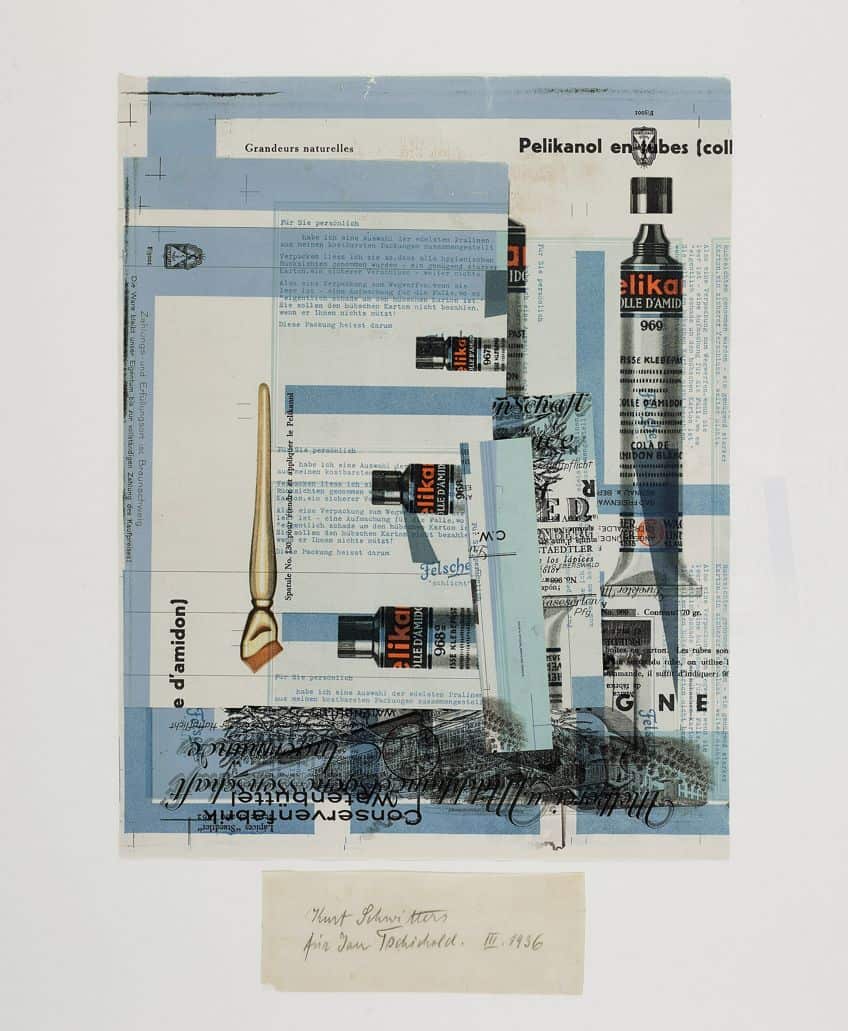
A 3D Collage: Merzbau (1923 – 1937)
| Title | Merzbau |
| Date | 1923 – 1937 |
| Medium | Mixed media |
| Dimensions (cm) | N/A |
| Style | Merz, site-specific art, and installation |
| Art Movement | Dadaism |
| Location | The original no longer exists. The copy is located in Sprengel Museum, Hannover, Germany |
Merzbau, the iconic installation by Kurt Schwitters, is an awe-inspiring architectural labyrinth that defied traditional notions of space, form, and artistic practice. Originally conceived in 1923, Merzbau underwent multiple iterations over the years and became an ever-evolving masterpiece. It occupied several rooms of Schwitters’ living space, first in Hanover, Germany, and later in his exile in Norway and England.
Merzbau was a fusion of sculpture, architecture, and collage, creating an immersive environment that engulfed viewers in a surreal and dynamic realm. Schwitters employed his signature Merz technique, incorporating found objects, wood, plaster, and various materials salvaged from everyday life. The result was a chaotic, yet harmonious assemblage of fragments and forms, blurring the boundaries between art and life.
The installation grew organically, with Schwitters continually adding new elements and expanding its reach.
It became a manifestation of Schwitters’ artistic vision, a physical embodiment of his desire to transform the ordinary into the extraordinary. Merzbau was a reflection of his personal experiences, emotions, and observations, encapsulating his response to the changing world around him.
Visitors entering Merzbau were met with a disorienting and immersive experience. The rooms were filled with intricate constructions, jagged shapes, and intersecting planes that defied conventional architectural norms. Walls, ceilings, and floors were layered with collaged materials, creating a dense and multi-dimensional tapestry of visual information. Each corner, crevice, and surface became an artistic statement, inviting viewers to explore and engage with the space.
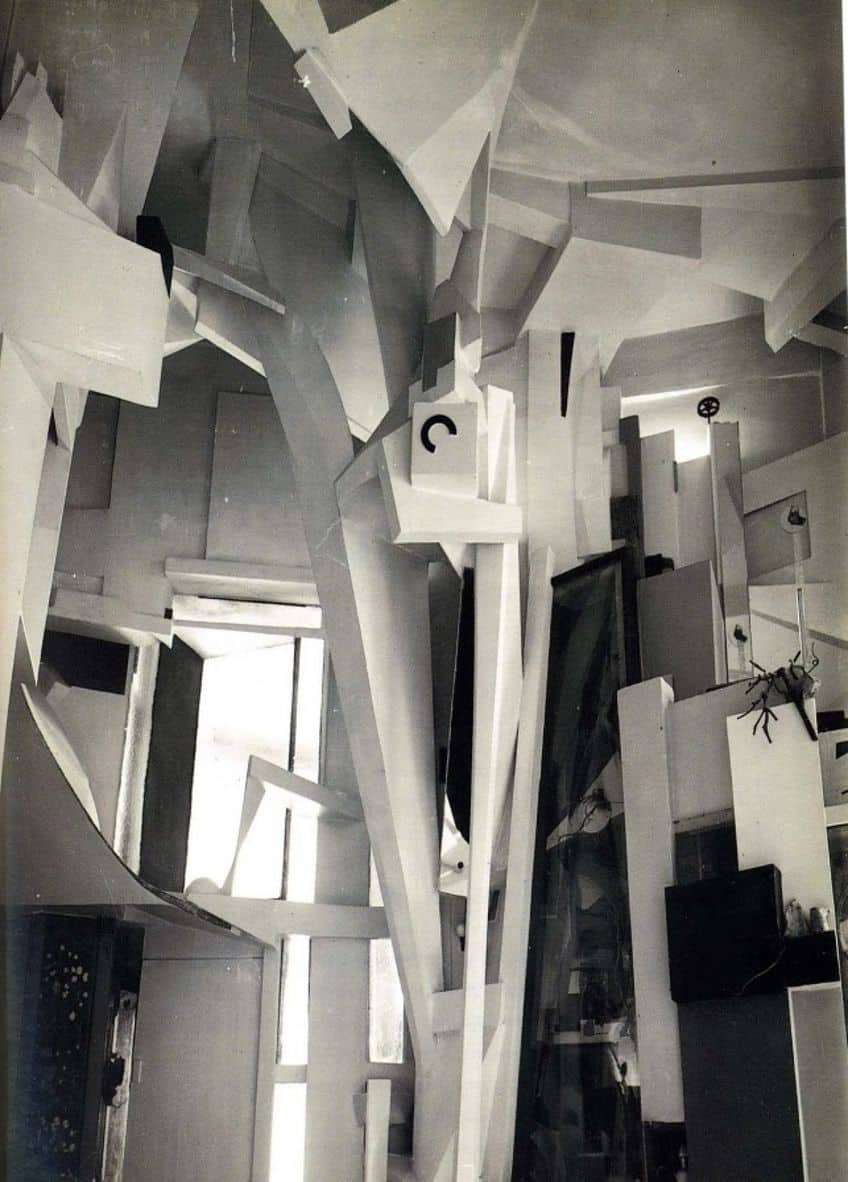
Merzbau transcended its physical presence, becoming a catalyst for artistic and intellectual dialogue. It inspired Schwitters’ contemporaries, including members of the Dada and Surrealist movements, who were captivated by its innovative and radical approach. The installation challenged preconceived notions of space, inviting viewers to question the nature of art and its relationship to the surrounding environment.
Tragically, Merzbau was never preserved in its entirety. During World War II, the Hanover iteration of the installation was destroyed in a bombing raid. However, Schwitters continued to work on new iterations, including the one in Norway, which met a similar fate due to a fire. Yet, fragments, photographs, and descriptions of Merzbau have allowed subsequent generations to grasp its profound impact and reimagine its awe-inspiring presence. Today, the legacy of Merzbau lives on as a testament to Schwitters’ innovative spirit and his willingness to challenge the confines of traditional artistic disciplines.
It remains an enduring symbol of artistic experimentation, pushing the boundaries of what is possible and inspiring artists to create immersive, transformative environments that blur the lines between art and life.
Public Reception
When Kurt Schwitters first began exhibiting his artworks in Germany, they were met with mixed reactions from the public. The German art scene at the time was primarily focused on traditional artistic styles, and Schwitters’ innovative and unconventional approach challenged the established norms. Some viewers were perplexed by his use of found objects and collaged materials, considering them to be chaotic and unconventional.

However, there were also those who recognized the groundbreaking nature of Schwitters’ work and appreciated his ability to transform ordinary objects into captivating artistic compositions. Over time, as Schwitters gained recognition and established himself as a leading figure in the avant-garde movement, his artworks began to garner more attention and appreciation from the German public. Today, there is even a part of Hannover called Kurt-Schwitters-Platz in which museums and memorials to this artist can be found.
Kurt Schwitters, with his groundbreaking Merz art style and innovative approach, left an indelible mark on the art world. His ability to transform ordinary objects into extraordinary works of art challenged traditional notions and paved the way for the development of new artistic movements. Through his collages, assemblages, and immersive installations like the Merzbau, Schwitters shattered the boundaries of artistic expression and invited viewers to reimagine the possibilities of creativity. His influence extended far beyond his lifetime, inspiring subsequent generations of artists and shaping the trajectory of modern art. Today, Schwitters’ legacy stands as a testament to the power of artistic experimentation, pushing boundaries, and the enduring impact of an artist who dared to defy convention. His contributions continue to captivate and inspire, reminding us of the transformative power of art to reshape our perception of the world.
Frequently Asked Questions
How Did Kurt Schwitters Die?
Kurt Schwitters died on January 8, 1948, in Kendal, England. He suffered from various health issues, including chronic asthma and cardiovascular problems. However, the exact cause of his death was attributed to a ruptured artery. Despite his untimely demise, Schwitters’ artistic contribution and avant-garde spirit continues to resonate and inspire artists and art enthusiasts to this day.
Where Did Kurt Schwitters Live?
Kurt Schwitters lived in various locations throughout his life. He was born in Hanover, Germany, and spent a significant part of his early life there. However, due to political and personal circumstances during World War Two, Schwitters was forced to flee Germany. He initially sought refuge in Norway, but was later interned as an enemy alien. After his release, Schwitters moved to England in 1940, where he settled in the Lake District town of Ambleside. He resided there until his death in 1948. The different places Schwitters called home played a role in shaping his artistic style and the themes explored in his works.
When Was Kurt Schwitters Born?
Kurt Schwitters was born on June 20, 1887. Kurt Schwitters was born into a middle-class family in Hanover, Germany. His father, Eduard Schwitters, was a successful businessman who owned a lingerie shop, while his mother, Henriette Schwitters, managed the household. Growing up in a relatively comfortable environment, Schwitters had the opportunity to explore his artistic inclinations from an early age. His family’s support and resources played a role in nurturing his artistic talent and providing him with the foundation to pursue a career in the arts.
Why Was Kurt Schwitters Such an Influential Artist?
Kurt Schwitters’ artistic journey from his childhood to his association with the Dada movement exemplifies his creative brilliance and innovative spirit. His Merz collages and magazines became iconic symbols of his artistic vision, influencing not only Dadaism but also the trajectory of modern art. Schwitters’ legacy endures as a testament to his unwavering commitment to pushing the boundaries of artistic expression and challenging established norms.
What Was Schwitters’ Influence on the Rise of Dadaism?
Kurt Schwitters’ Merz art style was a powerful force that influenced and led to the rise of Dadaism. In the tumultuous post-war context, artists turned to these radical art movements as a means of grappling with the chaos and disarray of the world. Schwitters’ approach of blurring boundaries and utilizing found objects provided a new language for artistic expression, giving birth to the revolutionary spirit of Dadaism. The legacy of Schwitters’ Merz and its impact on Dadaism endures as a testament to the power of art to confront and reshape society in times of upheaval.
Nicolene Burger is a South African multi-media artist, working primarily in oil paint and performance art. She received her BA (Visual Arts) from Stellenbosch University in 2017. In 2018, Burger showed in Masan, South Korea as part of the Rhizome Artist Residency. She was selected to take part in the 2019 ICA Live Art Workshop, receiving training from art experts all around the world. In 2019 Burger opened her first solo exhibition of paintings titled, Painted Mantras, at GUS Gallery and facilitated a group collaboration project titled, Take Flight, selected to be part of Infecting the City Live Art Festival. At the moment, Nicolene is completing a practice-based master’s degree in Theatre and Performance at the University of Cape Town.
In 2020, Nicolene created a series of ZOOM performances with Lumkile Mzayiya called, Evoked?. These performances led her to create exclusive performances from her home in 2021 to accommodate the mid-pandemic audience. She also started focusing more on the sustainability of creative practices in the last 3 years and now offers creative coaching sessions to artists of all kinds. By sharing what she has learned from a 10-year practice, Burger hopes to relay more directly the sense of vulnerability with which she makes art and the core belief to her practice: Art is an immensely important and powerful bridge of communication that can offer understanding, healing and connection.
Nicolene writes our blog posts on art history with an emphasis on renowned artists and contemporary art. She also writes in the field of art industry. Her extensive artistic background and her studies in Fine and Studio Arts contribute to her expertise in the field.
Learn more about Nicolene Burger and the Art in Context Team.
Cite this Article
Nicolene, Burger, “Kurt Schwitters – Discover Kurt Schwitters Artwork.” Art in Context. July 17, 2023. URL: https://artincontext.org/kurt-schwitters/
Burger, N. (2023, 17 July). Kurt Schwitters – Discover Kurt Schwitters Artwork. Art in Context. https://artincontext.org/kurt-schwitters/
Burger, Nicolene. “Kurt Schwitters – Discover Kurt Schwitters Artwork.” Art in Context, July 17, 2023. https://artincontext.org/kurt-schwitters/.








